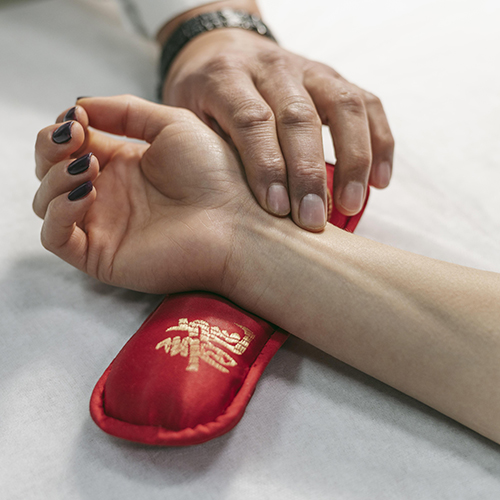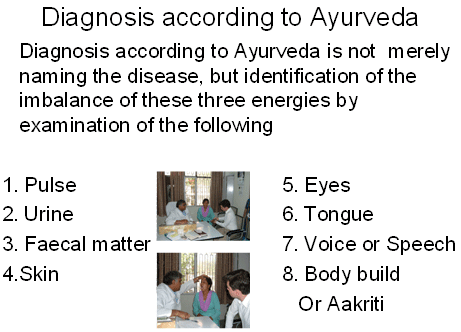
Overview
Diagnosis as per to Ayurveda is not merely naming the disease, but identification of the imbalance of tri-energies (Doshas).
The emphasis while diagnosing is laid mainly on non-invasive techniques and comprehensive questioning about sleep, appetite, general behavior. Generally the analysis is made by observing the symptoms and looking for various signs. The symptoms are the ones which are shared by the patient to the doctor and the signs are observed only by the physician. A good physician can easily make out diagnosis depending upon the signs, which are totally based on observational insight of the person.
Ancient sages laid emphasis on the observational technique and preferred it over invasive techniques. All the methods are used to observe the various characteristics of various energies (Doshas), just to evaluate their proportionate imbalance.
For example, if someone has dryness, restlessness, weird dreams about flying and falling, tingling sensation anywhere on the body or muscle cramps that means his Vata (Kinetic energy) is disturbed. If he suffers from acidity, burning eyes, hands and feet, blood pressure, skin eruptions and dreams of fire, light flashes etc. that means his “Pitta” or fire energy is disturbed. Similarly if someone feels heavy, lethargic, fatigued, sleepy, dreams about drowning is suffering from disturbed “Kapha” (Potential energy). There are many other things which are observed to conclude about imbalance of doshas.
These factors which are mainly non-invasive are:-
- Eight Fold methods of diagnosis – Ashtvidha Parikshan
- Prakriti – Body & Mental Constitution
- Kaal (Time) – Age, relation of signs and symptoms with time and seasons
- Pathogenesis – Various stages of the disease development
The Eight Methods of Diagnosis – Ashtvidha Parikshan in Ayurveda
These are excellent ways for judging the imbalance of tri-energies. The Ayurvedic Vaidya scrutinizes the following for making a diagnosis.

| THESE EIGHT FOLD METHODS OF DIAGNOSIS ARE | |
| Pulse (Naadi) | Eyes (Drik) |
| Urine (Mootram) | Tongue (Jivha) |
| Faecal matter (Malam) | Voice or Speech (Shabdh) |
| Skin (Sparsh) | Body Build (Aakriti) |
ASHTAVIDHA PARIKSHA – NAADI PARIKSHA AND OTHERS
1. Pulse Diagnosis
This is one of the most significant method of diagnosis in Ayurveda. Many Vaidya’s can make the diagnosis only by examining the pulse. This method of diagnosis is known as “Naadi Parikshan” in Ayurveda. The strength, rhythm, speed, quality of the pulse are examined to come at a conclusion. The Vata pulse is fast, irregular, moves like a snake. In modern medicine it can be compared with thread, irregular pulse. The Pitta pulse is throbbing, forceful, rich and elevated in the middle. It can be compared to the jumping frog. The Kapha pulse is slow, steady and somewhat heavy. It can be compared to the movement of a crane.
Sometimes the pulse is overlapping and with experience it can be felt that a thick layer of coating is moving with the pulse. The pulse is coated with “Ama”. This can lead to diagnosis of auto-immune disease or can predict many other diseases.
2. Urine Examination
The urine is examined by naked eye to check for its color, consistency, frequency, sediments if any.
3. Stool Examination
Direct examination of the faecal matter by naked eye can tell a lot about digestive fire. The color, consistency, floating nature, smell, presence of blood or mucus can give a lot of clues about various doshas imbalances.
4. Tongue Examination
The color, shape, coating can be indicative of many dosha abnormalities:
- Eyes Examination – The color of sclera, conjunctiva, size of eye ball, dryness, shape, area around eyes give insight into various serious metabolic diseases.
- Speech or Voice – The person’s ability or strength to speak, continuity, hoarseness etc. can give hint about many underlying disease processes.
- Skin – Skin temperature, its color, tenderness, abnormality in pattern can inform about many chronic conditions.
- Body – Built or General Appearance – An experienced Vaidya can get a lot of information from general appearance from the person. The overall built is indicative of the amount of strength, stamina and life force. Examination of hair, nails and other body organs can reveal many signs which point towards different diseases.
5. Body & Mental types – Prakriti Analysis – Diagnosis by knowing constitution
Every human being is unique. Therefore Ayurveda recommends different kind of medicines for every person even if they are suffering with the same disease. The medicines are not prescribed because of the symptoms or severity of the disease but the individual body type, mental type as well as the symptoms and severity of the disease.
Every individual is different. Every person has different body & mental type which is called “Prakriti” (Constitution) of the person. So individual constitutional analysis is a very important tool to know about individual predisposition for various diseases and can also predict a lot about ongoing illness.
6. Time
According to Ayurveda, the tri-energies level change in various times. During childhood the Kapha is higher, that’s why kids generally suffer from respiratory tract illnesses and sleep is sound and generally happiest of all ages of human life. Youth is the Pitta time, so young people mainly suffer from disturbed fire element diseases like acne, premature falling & graying of hair, aggression, jealousy, anger, mood fluctuations. Old age is the time for disturbance in Vata (Air) energy. So the nervous system is affected, mobility is altered, painful joint conditions develop and the sleep becomes scanty.
Similarly seasons in the year have great impact on body immunity. The imbalance of tri-energies can be judged by keeping this in mind.
Here is a layman’s analogy which is helpful in understanding the natural course of tri-energies in human life. This is not written anywhere in Ayurveda but this is what is actually happening in today’s society.
| Age Group | General Behavior | Description |
| Age 0 to 10 years | Child always “Spills” | The kids generally keep on Spilling, i.e. Childhood is the time of “Kapha” |
| 10 to 20 years | Teenage “Thrills” | The hormonal changes, leading to Acne, Thrilling behavior in life, mood swings- Pitta increasing and Kapha normalizing |
| 20-30 years | Youth time- “Wills” | Starts to take his career seriously, he wills, wishes, desires are high – Its High Pitta time |
| 30-40 | Pays “Bills” | The most stressful period in a man’s life. During this time of life, the person is settled in his career and is busy in paying his “Bills” This is again high Pitta time, Vata just starts to vitiate, causing anxiety & related problems. |
| 40-50 | Bills & Pills | If a person ignores his health during the “Bills” period, the pills come in his life. |
| 50-60 | Pills – Kills | The life is crippled due to modern life style. Although it is claimed that the life span has increased but the quality of life has decreased tremendously. It’s mainly because of the Pills, fertilizers & pesticides in agriculture, packaged foods, synthetic coloring agents, flavoring agents, preservatives and particularly faulty life style. |
| 60 Onwards | Life Kills | Although the person is living and trying to enjoy as much possible, but again the life force is deteriorating exponentially. Only the Ayurvedic way of living can prevent this. |
